Electrostatics Formulas
Searching for a One-Stop Destination where you will find all the Electrostatics Formulas? If so, you have come the right way and we have listed all the important formulae on this page. Make the most out of the Electrostatics Formula Sheet and get a good hold on the concepts. Utilize the Cheat Sheet for Electrostatics and try to memorize the formula so that you can make your calculations much simple.
Need any other assistance on various concepts of the Subject Physics then look out our Physics Formulas and get acquainted with the underlying concepts easily.
Electrostatics Cheat Sheet & Tables
1. Fundamental forces of nature
- Gravitational
- Electromagnetic,
- Nuclear,
- Weak.
Relative strength 1 : 1036 : 1039 : 1014
Charge is quantised, the quantum of charge is e = 1.6 × 10-19 C.
Charge is conserved, invariant, additive
2. CoulombΓÇÖs law
\(\overrightarrow{\mathrm{F}}=\mathrm{K} \frac{\mathrm{q}_{1} \mathrm{q}_{2}}{\mathrm{r}^{2}} \hat{\mathrm{r}}\)
K = \(\frac{1}{4 \pi \varepsilon_{0}}\) = 9 × 109\(\frac{\mathrm{Nm}^{2}}{\mathrm{C}^{2}}\)
ε0 = 8.854 × 10-12\(\frac{C^{2}}{N m^{2}}\)
= Permittivity of free space
\(\frac{\varepsilon}{\varepsilon_{0}}\) = ╬╡r = Relative permittivity or dielectric constant of a medium.
\(\overrightarrow{\mathrm{E}}=\frac{\mathrm{Kq}}{\mathrm{r}^{2}} \hat{\mathrm{r}}\)
Note: – If a plate of thickness t and dielectric constant k is placed between the j two point charges lie at distance d in air then new force
\(\mathrm{F}=\frac{\mathrm{q}_{1} \mathrm{q}_{2}}{4 \pi \varepsilon_{0}(\mathrm{d}-\mathrm{t}+\mathrm{t} \sqrt{\mathrm{k}})^{2}}\)
effective distance between the charges is
d’ = (d – t + t\(\sqrt{\mathrm{k}}\))
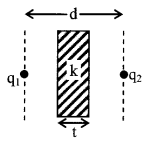
3. Intensity of electric field
\(\overrightarrow{\mathrm{E}}\) = Force on a unit positive charge = \(\frac{\overrightarrow{\mathrm{F}}}{\mathrm{q}_{0}}\) N/C or V/m.
Due to a point charge q intensity at a point of positive vector \(\overrightarrow{\mathrm{r}}\)
\(\overrightarrow{\mathrm{E}}=\frac{\mathrm{Kq}}{\mathrm{r}^{2}} \hat{\mathrm{r}}\)
4. Electric potential
Work done against the field to take a unit positive charge from infinity (reference point) to the given point.
VP = – \(\int_{\infty}^{P} \vec{E} \cdot \overrightarrow{d r} \text { volt }\)
Due to a point charge q, potential
V =K \(\frac{q}{r}\) volt
5. Principle of superposition
Resultant force due to a number of charges
\(\overrightarrow{\mathrm{F}}=\overrightarrow{\mathrm{F}}_{1}+\overrightarrow{\mathrm{F}}_{2}+\ldots . .+\overrightarrow{\mathrm{F}}_{\mathrm{n}}\)
Resultant intensity of field
\(\overrightarrow{\mathrm{E}}=\overrightarrow{\mathrm{E}}_{1}+\overrightarrow{\mathrm{E}}_{2}+\ldots . . \overrightarrow{\mathrm{E}}_{\mathrm{n}}\)
Resultant potential V = V1 + V2 + … + Vn
6. Relation between \(\overrightarrow{\mathrm{E}}\) and V
\(\overrightarrow{\mathrm{E}}\) = – grad V = – \(\vec{\nabla} V=-\frac{\partial V}{\partial r} \hat{r}\)
In cartesian coordinates
\(\overrightarrow{\mathrm{E}}=-\left[\hat{\mathrm{i}} \frac{\partial \mathrm{V}}{\mathrm{dx}}+\hat{\mathrm{j}} \frac{\partial \mathrm{V}}{\partial \mathrm{y}}+\hat{\mathrm{k}} \frac{\partial \mathrm{V}}{\partial \mathrm{z}}\right]\)
7. Electric flux
Treating area element as a vector
d╬ª = \(\overrightarrow{\mathrm{E}} \cdot \overrightarrow{\mathrm{ds}}\), ╬ª = \(\int_{s} \overrightarrow{\mathrm{E}} \cdot \overrightarrow{\mathrm{ds}}\) volt – metre
8. GaussΓÇÖs theorem
Total outward flux through a closed surface = (4πK) times of charge enclosed
or Φ = \(\oint \overrightarrow{\mathrm{E}} \cdot \overrightarrow{\mathrm{ds}}=4 \pi \mathrm{K} \sum \mathrm{q}=\frac{1}{\varepsilon_{0}} \Sigma \mathrm{q}\)
9. Intensity and potential due to a non-conducting charged sphere
\(\overrightarrow{\mathrm{E}}_{\text {out }}=\frac{1}{4 \pi \varepsilon_{0}} \frac{\mathrm{Q}}{\mathrm{r}^{2}} \hat{\mathrm{r}}, \mathrm{E}_{\text {out }} \propto \frac{1}{\mathrm{r}^{2}}\)
\(\overrightarrow{\mathrm{E}}_{\text {surface }}=\frac{1}{4 \pi \varepsilon_{0}} \frac{\mathrm{Q}}{\mathrm{R}^{2}} \hat{\mathrm{r}}\)
\(\overrightarrow{\mathrm{E}}_{\text {inside }}=\frac{1}{4 \pi \varepsilon_{0}} \frac{\mathrm{Q}}{\mathrm{R}^{3}} \overrightarrow{\mathrm{r}}, \quad \mathrm{E}_{\text {inside }} \propto \mathrm{r}\)
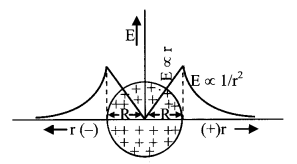
Vout = K \(\frac{Q}{r}\), Vsurface = K \(\frac{Q}{r}\)
and Vinside = \(\frac{\mathrm{KQ}\left(3 \mathrm{R}^{2}-\mathrm{r}^{2}\right)}{2 \mathrm{R}^{3}}\)
Vcentre = \(\frac{3}{2} \frac{\mathrm{KQ}}{\mathrm{R}}\) = 1.5 Vsurface
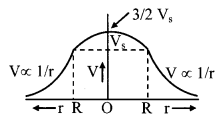
10. Intensity and potential due to a conducting charged sphere
Whole charge comes out on the surface of the conductor.
\(\overrightarrow{\mathrm{E}}_{\text {out }}=\frac{1}{4 \pi \pi_{0}} \frac{\mathrm{Q}}{\mathrm{r}^{2}} \hat{\mathrm{r}}\)
\(\overrightarrow{\mathrm{E}}_{\text {surface }}=\frac{1}{4 \pi \varepsilon_{0}} \frac{\mathrm{Q}}{\mathrm{R}^{2}} \hat{\mathrm{r}}\)
\(\overrightarrow{\mathrm{E}}_{\text {inside }}=0\)
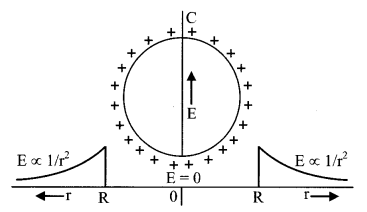
Vout = K\(\frac{Q}{r}\)
Vsurface = K\(\frac{Q}{R}\)
Vinside = K\(\frac{Q}{R}\) (Constant)

11. Electric potential and field intensity due to a charged ring
On axis
V = \(\frac{K Q}{\left(R^{2}+x^{2}\right)^{1 / 2}}\)
\(\overrightarrow{\mathrm{E}}=\frac{\mathrm{KQx}}{\left(\mathrm{R}^{2}+\mathrm{x}^{2}\right)^{3 / 2}} \hat{\mathrm{x}}\)
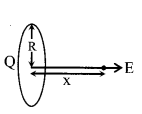
(x is the distance of the point on the axis from the centre)
At centre E = 0, V = \(\frac{\mathrm{KQ}}{\mathrm{R}}\)
Note: – If charged ring is semicircular then E.F. at the centre is
\(\frac{2 \mathrm{K} \lambda}{\mathrm{R}}=\frac{\mathrm{Q}}{2 \pi^{2} \mathrm{R}^{2} \varepsilon_{0}}\)
and potential V = \(\frac{\mathrm{KQ}}{\mathrm{R}}\)

12. Electric field intensity due to very long (∞) line charge
\(\overrightarrow{\mathrm{E}}=\frac{2 \mathrm{K} \lambda}{\mathrm{r}} \hat{\mathrm{n}}=\frac{1}{2 \pi \varepsilon_{0}} \frac{\lambda}{\mathrm{r}} \hat{\mathrm{n}}\)
\(\hat{\mathrm{n}}\) is a unit vector iionpjd to line charge.
13. Electric field intensity due to a charged sheet having very large (∞) surface area
\(\overrightarrow{\mathrm{E}}\) = 2πK σ \(\hat{\mathrm{n}}\) (constant)
σ → charge of unit cross section
14. Electric field intensity due to an infinite charged conducting plate
\(\overrightarrow{\mathrm{E}}\) =4πKσ \(\hat{\mathrm{n}}=\frac{\sigma}{\varepsilon_{0}} \hat{\mathrm{n}}\)(constant)
σ → charge of unit surface area
15. Electric dipole
Two equal and opposite point charges separated by a small distance. Dipole moment \(\overrightarrow{\mathrm{p}}=\mathrm{q} \overrightarrow{\mathrm{d}}\). Direction of \(\overrightarrow{\mathrm{p}}\) is from -q to + q.
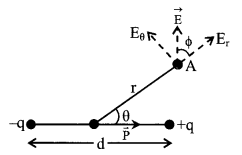
Potential at a point A (r, ╬╕)
V = \(\frac{\mathrm{Kqd} \cos \theta}{\mathrm{r}^{2}}\)
V = \(\frac{\mathrm{Kp} \cos \theta}{\mathrm{r}^{2}}=\mathrm{K} \frac{\overrightarrow{\mathrm{p}} \cdot \overrightarrow{\mathrm{r}}}{\mathrm{r}^{3}}\)
Electric field intensity
E = \(\frac{\mathrm{p}}{4 \pi \varepsilon_{0} \mathrm{r}^{3}} \sqrt{1+3 \cos ^{2} \theta}\)
Er = 2K\(\left(\frac{\mathrm{p} \cos \theta}{\mathrm{r}^{3}}\right)\)
E╬╕ = K \(\left(\frac{p \sin \theta}{r^{3}}\right)\)
E = \(\sqrt{\mathrm{E}_{\mathrm{r}}^{2}+\mathrm{E}_{\theta}^{2}}\)
On axis ╬╕ = 0, Er = E = \(\frac{2 \mathrm{kp}}{\mathrm{r}^{3}}\)
On equatorial ╬╕ = \(\frac{\pi}{2}\), E╬╕ = E = \(\frac{\mathrm{Kp}}{\mathrm{r}^{3}}\)
Angle between E.F. at point A and x – axis is (╬╕ + ╬ª)
where tan Φ = \(\frac{1}{2}\) tan θ
16. Dipole in an electric field
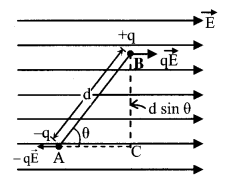
In a uniform field Fnet = 0, (No translatory motion)
Torque \(\vec{\tau}=\overrightarrow{\mathrm{p}} \times \overrightarrow{\mathrm{E}}\) or τ = pE sin θ
Potential energy of dipole
U = – \(\overrightarrow{\mathrm{p}} \cdot \overrightarrow{\mathrm{E}}\)
(dipole perpendicular to field is taken as reference state). Work done in rotating the dipole from ╬╕1 to ╬╕2.
W = U2 – U1 = pE (cos ╬╕1 – cos ╬╕2)
Time period of oscillation of electric dipole in uniform E.F.
T = 2π\(\sqrt{\frac{I}{P . E}}\);
I = moment of inertia
17. Equilibrium of charged soap bubble
For a charged bubble
Pext + Pelct. = \(\frac{4 \mathrm{T}}{\mathrm{r}}\)
For Pext = 0, Pelct. = \(\frac{4 \mathrm{T}}{\mathrm{r}}\)
or \(\frac{\sigma^{2}}{2 \varepsilon_{0}}=\frac{4 T}{r}\)
Electric field on surface
Esurface = \(\left(\frac{8 \mathrm{T}}{\varepsilon_{0} \mathrm{r}}\right)^{1 / 2}\)
Potential on surface
Vsurface = \(\left(\frac{8 \mathrm{Tr}}{\varepsilon_{0}}\right)^{1 / 2}\)
18. Energy density in electric field
U = \(\frac{1}{2}\) ╬╡0E2 (J/m3)
19. When small drops of charge q forms a big drops of charge Q
Q = nq, R = r n1/3
Vbig =n2/3 Vsmall
20. Electric break-down or electric strength
Max. electric field can be created in the given medium.
For air Emax = 3 × 106 V/m
Seek help on various concepts taking the help of Formulas provided on the trusted portal Physicscalc.Com and clear all your ambiguities.